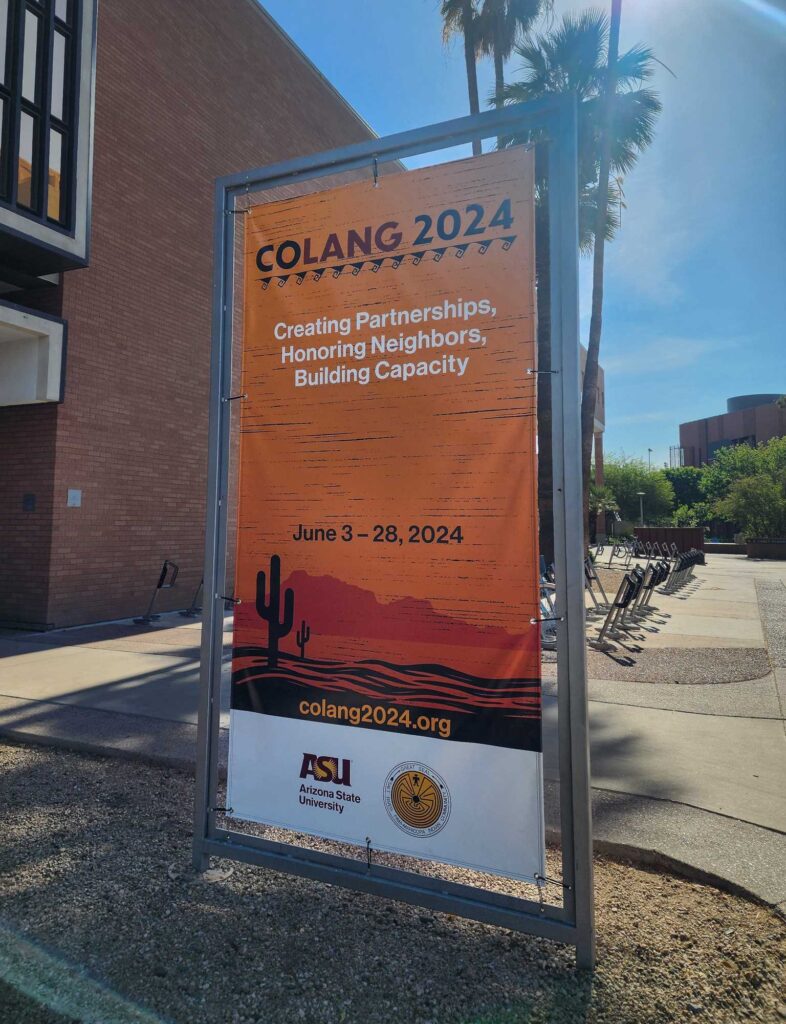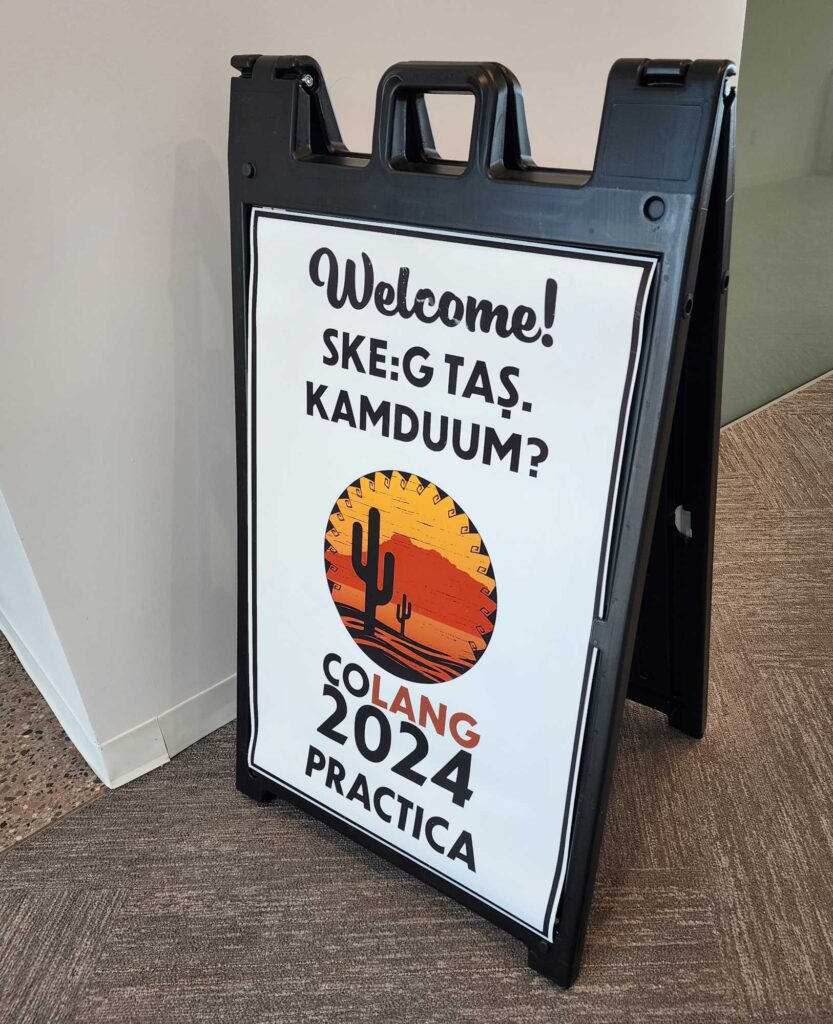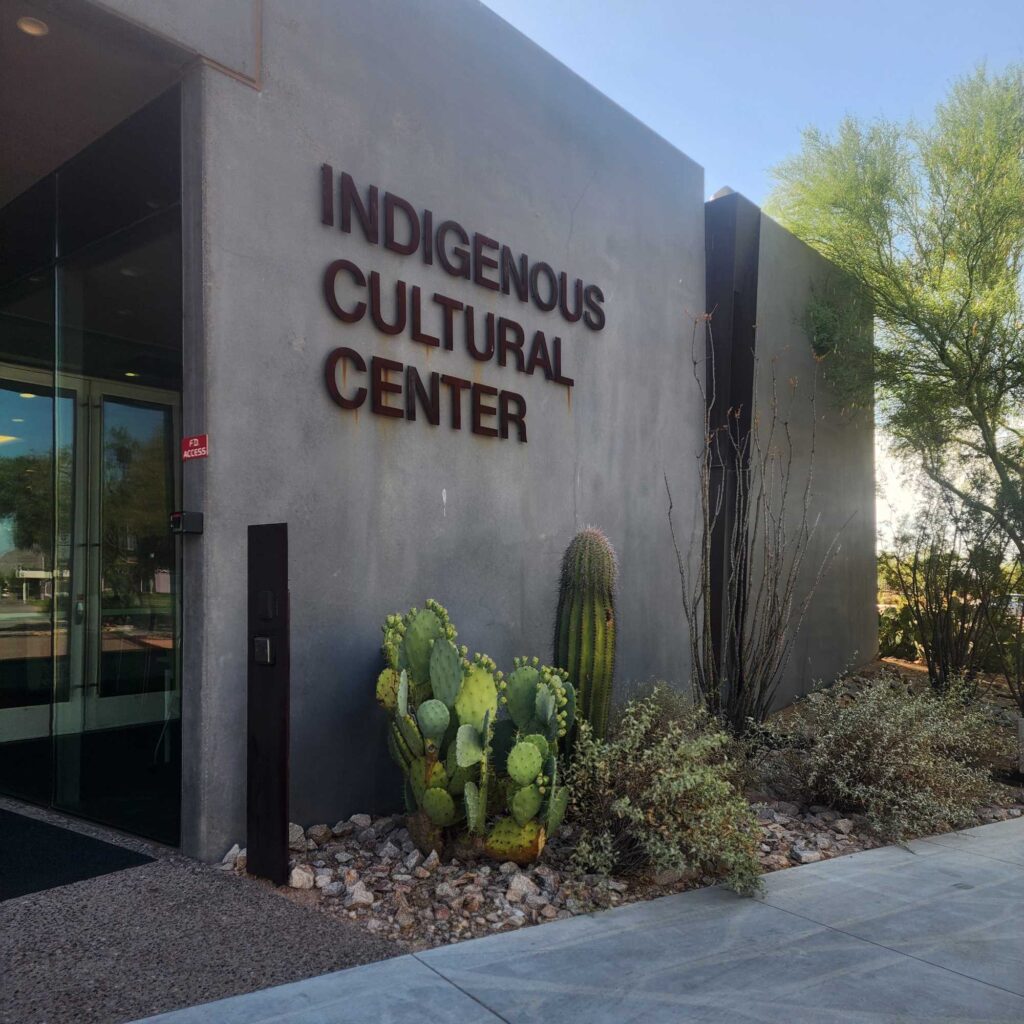- Home
- >
- Preservation Archaeology Blog
- >
- Revitalizing and Reclaiming Indigenous Languages: ...
(October 7, 2024)—This past summer, from June 3 to 28, I had the pleasure of attending CoLang. Formally known as the Institute on Collaborative Language Research, CoLang is a biennial institute centered on training in language revitalization and Indigenous community-based collaboration. Inspired by the CoLang Institute held in 2022 in Missoula, Montana, members from the Salt River Pima-Maricopa Indian Community (SRPMIC) decided to host the next CoLang in Phoenix, Arizona.

Now, how did we, an archaeology organization, find out about CoLang? During cyberSW’s collaboration outreach on a project with SRPMIC, the O’odham Piipaash Language Program manager, Luis Barragan, mentioned CoLang and its linguistic training potential. Attending CoLang was a must for someone (me) who is not a trained linguist but would like to improve their skill set for a language revitalization project.
CoLang was a monthlong venture consisting of two weeks of Workshop and two weeks of Practica that allowed participants to apply the skills they gained from the workshops. I had only registered for the Workshop but was happy to return for the last day of Practica at Luis Barragan’s invitation. I’ll speak more on the Practica later in this post.
Workshops
From 8:00 a.m. to 5:00 p.m., I dusted off my student cap for two solid weeks and actively engaged with a diverse cohort comprising language learners, members fluent in their language, and linguists. Attendees and workshop facilitators of CoLang were Indigenous peoples and allies from around the world. (My heart went out to the peoples of Papua New Guinea and the Cook Islands who left their tropic and subtropic climates for the desert of Phoenix in June!) Although attendees were from diverse locations, we all shared a similar goal of promoting Indigenous language reclamation and healing through community-based projects.
I thoroughly enjoyed the varied workshop offerings, and choosing only a handful of sessions to attend was difficult. My workshops included specialized courses such as designing and implementing a database (Amy Fountain, John Ivens, and Gus Hahn-Powell), using technology in language reclamation (Jack Rittenberry and Hali Dardar), an intro linguistics course focused on morphology/syntax (Stacey Oberly), and revitalizing Traditional Ecological Knowledge using heritage materials (Jonathan Geary).
The additional workshops I chose were more theory-based, where we explored the blurred lines of collaboration between language-revitalization advocacy communities and linguists (Jean-Luc Pierite), mobilizing community language-revitalization initiatives (First Peoples’ Cultural Council), and navigating intellectual property of Indigenous Knowledge (Susan Smythe Kung), all wrapped up with a sincere and introspective discussion regarding the intricacies of revitalizing Indigenous traditions in this time and space (Phillip Cash Cash).
Models Talks
During our afternoon break between workshop blocks, all CoLang participants were invited to attend Models Talks, one-hour plenary presentations of language projects from local and international scholars, Indigenous community members, and allies. Amid the echoes of the injustices of the past and the lingering grasp of settler colonialism, there is still joy and hope found in the resilience of Indigenous peoples.
A positive tone was set on day one of CoLang, when members from the Chickasaw Nation, including Lokosh (Joshua D. Hinson), shared their Nation’s accomplishments in language revitalization. The Chickasaw Nation’s Department of Language, supported by the Nation’s Governor Bill Anoatubby, has broken barriers to create a language program with Rosetta Stone and an online platform called Chickasaw.tv dedicated to preserving the language and culture of the Chickasaw people. From this incredible language support system, we as an audience were delighted by a video of a very young child from the Chickasaw Nation speaking fluently in her traditional language. My eyes, and those of many, welled with tears—an emotional release as the mixture of optimism, excitement, and determination briefly stifled the suffocating grip of depression and anxiety that comes with the trauma of language loss.
The excitement and communal joy fostered by CoLang also empowered communities to address the glaring crisis of Indigenous language loss and its associated trauma. Although not always explicitly addressed in the CoLang program, the pervasive reverberations of trauma from Indigenous language loss still linger like a shadow. It is found in the stories of Indigenous peoples from communities where their last fluent speaker has passed, and their language is now considered extinct. The blunt honesty of Elders acknowledging their time in this world is finite, and their skills must be shared or lost. The realization that the language genocide of colonial assimilation and termination tactics affected not only spoken Indigenous languages but also their respective sign language. It’s a specific fear and sense of loss we carry with us, a feeling that the dominant society is often privileged to avoid experiencing. Language is the heart of culture. To lose our language is to lose our culture—our identity.
This is but a glimpse into the trauma of Indigenous language loss. There is urgency and heavy responsibility involved with language projects, but a human element must also be within a project to hold space for understanding, healing, and recovery. It’s crucial for outsiders and allies who wish to engage in research projects with Indigenous communities to acknowledge. Each Tribal Nation’s situation is unique, and there can be spectra of challenges involved with language revitalization. I’ve included some of the Models Talks for further consideration at this blog’s end.
Highlighted Workshops
Here, I’d like to share my thoughts on two particular workshops: their impact on my work with Archaeology Southwest and their connection to overall themes concerning language revitalization.
Traditional Ecological Knowledge and Language Revitalization
I find joy in browsing through heritage materials to identify a species. That statement is mostly positive but carries very subtle hints of dread, as I’ve observed that most early ethnographers and linguists were not taxonomists but would still attempt to identify species. Now, I’m not referring to the misidentification of a species due to a language barrier. No. I’m referring to the misinterpretation of species by non-biologists or the use of colloquial names for species. A few examples from an ornithological perspective would be the generalization of small songbirds under the name of “sparrow”; the grouping of egrets, herons, and bitterns under the classification of “crane”; or the use of “chickenhawk” to refer to birds of prey that can be guilty of hunting chickens. Such errors are among the challenges encountered during a language revitalization project when fluent speakers are too few or when the language is extinct and a researcher must resort to heritage materials.
This is where I connected with Jonathan Geary, a linguist and ornithologist who had worked with the SRPMIC language program and is currently working with the Shingle Springs Band of Miwok Indians in their Language Department. Jonathan led the workshop on Reconstructing Traditional Ecological Knowledge using heritage language materials. I felt a bit validated as we both shared the same aforementioned struggle of identifying species from heritage materials. As practice during this workshop, our cohort was tasked with identifying a bird species associated with the name of xomάse’ in Piipaash and documented as a “chicken hawk” by anthropologists and ethnographers (photo).
![Geary, J. (2024). Reconstructing Traditional Ecological Knowledge using heritage language materials [PowerPoint Slides], Institute of Collaborative Language Research.](https://www.archaeologysouthwest.org/wp-content/uploads/Screenshot-2024-09-06-123337.png)
Technology and Language Reclamation
The second workshop I want to highlight is the Technology and Language Reclamation workshop led by Jack Rittenberry (ally community linguist) and Hali Dardar (United Houma Nation) of the Houma Language Project. Using technology to reclaim Indigenous language is a delicate field to navigate because Indigenous knowledge and culture has been historically exploited—usually in print or multimedia publications. With advancements in technology, we have innovative means for language-revitalization projects that use language databases or applications to reach a larger audience of language learners. This presents a great opportunity for Indigenous language learners caught in the Native diaspora and disconnected from their Tribal Nation or for those whose language has been classified as extinct or endangered and work is being done to preserve the knowledge. Jack and Hali shared their experience with the Houma Language Project and how they navigated platforms and digital tools for inspired community members interested in using technology to reclaim Indigenous languages. Digital literacy and taking steps to understand the complexities of Indigenous Knowledge and intellectual property are essential in this evolving digital environment.
Creating and managing your own database can be demanding and even formidable at times. As a result, Indigenous language projects will often use established software and databases, much like the Houma Language Project and their use of 7000 Languages, an online language-learning software. Attention must be paid to hidden details involved with some of these tools, however, in order to protect the intellectual property of Indigenous knowledge and language. In 7000 Languages’ “small print” on their ownership, rights, and access page, there is verbiage that recognizes language ownership and how language data will be used in their software. To create a language project with 7000 Languages, the user must consent to a Memorandum of Understanding with 7000 and a third-party called Transparent Language, which donates the language-learning software to 7000 Languages.
Details like engaging in an MOU outside of the relationship between the scholar and the Tribal Nation can be contentious, as some Nations might have strict protocols regarding language and knowledge-sharing being limited strictly to the community. Additionally, engaging in an MOU with a sublicense can add more concern to Indigenous Nations regarding protection and ownership of intellectual property.
Although our cyberSW team wouldn’t claim to be perfect, we are thankfully in a position to manage our database to adapt and develop a small language project aligned with the requests and expectation of our partnering Indigenous Nation to protect their intellectual property. For Indigenous Nations or community-based language projects that don’t have the capacity to develop their own digital language software/database, these platforms can be helpful as long as all parties are aware of how each platform manages language data and defines ownership, rights, and access.
Practica
During the midway point of CoLang, students transitioned from the Workshop series to the Practica to showcase their skills in working with Elders and community members from three unique Indigenous Nations. The communities, and their language-project focus, included Akimel O’odham linguistic documentation and analysis; the development of natural language-processing tools for the Māori language; and mentor-apprentice methodologies for immersion programs with the Piipaash community. Each practicum was facilitated by a mix of Elders, fluent speakers, and allies.


I returned for the last day of the Practica—a showcase by the participants in one of the three aforementioned focus areas. This was a moment of true wonder and significance; strangers from around the world worked together within their respective language group and slowly became friends and eventually a community. Although the language projects showcased by the participants were vital, I was beyond amazed by what had developed behind the scenes—a deep connection between participants and the facilitator found in the inside-jokes and artwork made by participants for Elders who shared their time and experience. Those kind gestures hopefully showed Elders that they are seen, needed, and respected. Community is a crucial element of language learning. There is a trust and environment that can allow students to feel free to come out of their comfort zone and feel like it’s okay to make mistakes—it’s all part of the learning and healing process.
I can only share my own experience of CoLang, but I do encourage those interested to check out the next CoLang 2026, wherever it might be located. The cost of a month-long participation may be a limiting factor; however, it’s worth noting that CoLang offers scholarships to help offset this expense, in the hope that all future CoLangs will offer the same enriching and rewarding environment.
Plenary and Models Talk: Further Resources
- Chickasaw language revitalization (Chickasaw.tv)
- Language revitalization project to create an open-access Mutsun-English Dictionary (Quirina Geary and Natalie Warner)
- Pakistan, Torwali Revitalization Project (Aftab Ahmad and Zubair Torwali)
Reclaiming Indigenous sign languages in the United States (Melanie McKay-Cody)
- Documenting Highland Mayan Indigenous sign language (Robert Henderson, Juan Ajsivinac Sian, Jeremy Kuhn, Sybil Vachaudez + Samantha Prins)
- Native American Language Resource Centers (NALRC) in Arizona (Ofelia Zepeda, Robert Elliott, Janne Underriner, Joana Jansen, and Leslie Harper)
- Establishing an O’odham Language Center and Early Childhood Immersion Program (Ronald Geronimo)
- Updates from the Coeur d’Alene Online Language Resource Center (Audra Vincent, Michelle Clark + Amy Fountain)